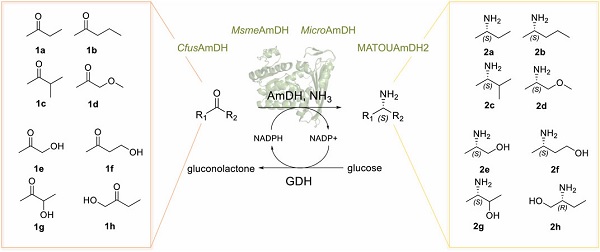Ducrot L., Bennett M., Caparco A., Champion J., Bommarius A., Zaparucha A., Grogan G., Vergne-Vaxelaire C.
Front. Catal., 2021, 1
Abstract
Small optically active molecules, and more particularly short-chain chiral amines, are key compounds in the chemical industry and precursors of various pharmaceuticals. Their chemo-biocatalytic production on a commercial scale is already established, mainly through lipase-catalyzed resolutions leading to ChiPros™ products among others. Nevertheless, their biocatalytic synthesis remains challenging for very short-chain C4 to C5 amines due to low enantiomeric excess. To complement the possibilities recently offered by transaminases, this work describes alternative biocatalytic access using amine dehydrogenases (AmDHs). Without any protein engineering, some of the already described wild-type AmDHs (CfusAmDH, MsmeAmDH, MicroAmDH, and MATOUAmDH2) were shown to be efficient for the synthesis of hydroxylated or unfunctionalized small 2-aminoalkanes. Conversions up to 97.1% were reached at 50 mM, and moderate to high enantioselectivities were obtained, especially for (S)-1-methoxypropan-2-amine (98.1%), (S)-3-aminobutan-1-ol (99.5%), (3S)-3-aminobutan-2-ol (99.4%), and the small (S)-butan-2-amine (93.6%) with MsmeAmDH. Semi-preparative scale-up experiments were successfully performed at 150 mM substrate concentrations for the synthesis of (S)-butan-2-amine and (S)-1-methoxypropan-2-amine, the latter known as “(S)-MOIPA”. Modeling studies provided some preliminary results explaining the basis for the challenging discrimination between similarly sized substituents in the active sites of these enzymes.


